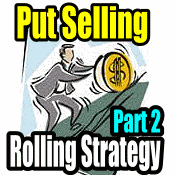Part 1 of this article on Put Selling rolling strategy ended at December 2008. By that point I had already done one put roll from October to January 2009 to avoid being assigned shares in ITW Stock at $42.50. By January 9 2009 ITW Stock was trading between $35 to $37 and I could tell that the chance of assignment would grow if I left it much longer. It is important when rolling puts to avoid assignment to roll early ahead of options expiry, particularly when the puts sold are deep in the money which mine were. Two weeks is normally my minimum period to roll when my sold puts are deep in the money.
When I refer to sold puts as deep I am referencing sold puts that are at least 8% deep.
Put Selling Roll Strategy – The Second Roll Out
On January 9 2009 with the stock treading sideways, I decided it was time to buy back and roll down and out my sold puts to move further away and delay any assignment longer. I picked April as the next period to do more put selling. Put selling premiums were not as good in January as they had been in October. Volatlity in the stock market was reduced by half making put premiums less. I bought back my 18 put contracts for January 2009 $42.50 strike for $7.65. I then sold 17 put contracts into April 2009 at $40.00 for $8.15.
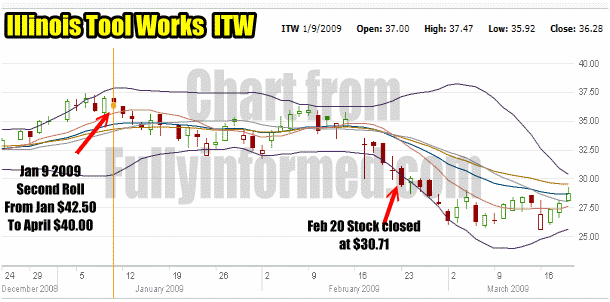
Put Selling Illinois Tool Works Stock January to Feb 2009 showing the second roll of put contracts.
Cost to buy back the 18 January 2009 $42.50 put contracts was $13799.50. The income earned from rolling out and down 17 put contracts for April at $40.00 was $13826.75. Again basically a breakeven on the roll down and I could only reduce the put contracts by 1 rather than the previous 2. With volatility down (see VIX chart below) considerably from October, the option premiums were lower making it impossible to roll down and reduce by more than 1 and still break-even.
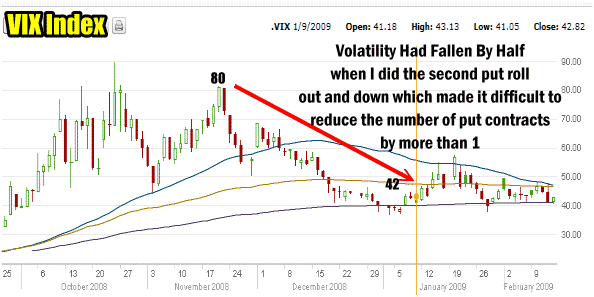
Volatility Had Fallen By Almost 50% By January 9 2009 making rolling the naked put contracts down and out and reducing the number of contracts by more than 1 difficult.
On Feb 20 2009 my luck held and ITW Stock ranged from $29.94 to a high of $31.95 and closed at $30.71. My Feb $30 naked puts expired.
March 2009 Stock Market Collapse
By March 2nd 2009 volatility was back climbing and I was surprised to see ITW Stock falling to $26.02 during the day. The next day I was back put selling again. This time with volatility spiking I sold the September $25.00 put for a terrific $4.90. This was a 19.6 percent return for holding the puts for 6 months. I felt it was a worthwhile trade.
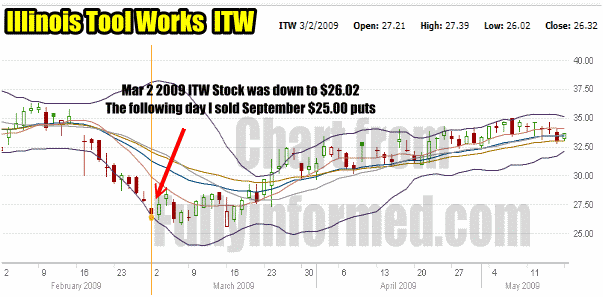
Put selling the September $25 ITW Stock strike
The plan now was to do one more roll of the April $40.00 puts out and down and try to reduce the put contracts by at least 1 but preferably 2 contracts, should the stock bounce back by the beginning of April.
Put Selling Roll Strategy – The Third Roll Out
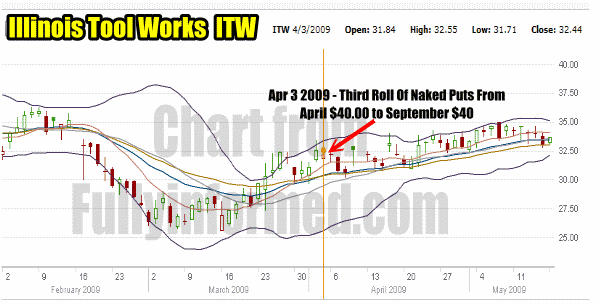
Put Selling Roll from April 2009 to September 2009 at $40.00 put strike marked the third roll of my naked puts,
On April 3rd 2009 with the stock above $32.00 I bought back the 17 April $40.00 put contracts and rolled into September at $40.00. I stayed at $40.00 because there was not enough put option premium when rolling to $37.50 to be able to reduce the number of put contracts by 2. I therefore stayed at $40.00 and rolled 15 put contracts into September.
The April $40.00 cost to close 17 put contracts was $9.10. Total Cost to close was $15,498.25 including commission.
I sold 15 September $40.00 naked puts for $10.90 for total income of $16324.25. This was an excellent put roll with a net credit of $826.00 and releasing 2 more put contracts from possible assignment.
Put Selling Returns To April 2009
As of April 2009 my put selling strategy had created the following:
Income from rolling puts down and out since the bear crash in October 2008 was only $859.25. The number of put contracts however had been reduced from 20 to 15 and I had been back put selling at lower strikes since October 2008.
Total income earned from put selling additional 5 put contracts since October 2008 was $4660.25. Capital at risk of assignment from put selling was 15 put contracts X $40.00 = $63,750.00 and 5 put contracts X $25.00 = $12,500.00. If assigned on both put positions my shares would be averaged at $38.12.
The total put selling income earned since the October crash was $5519.50 / $76,250.00 = 7.2%. Capital originally at risk of assignment with 2000 shares at $45.00 was $90,000. I had reduced my capital at risk of assignment from $90,000 to $76,250 or $13750.00. Added to that amount was the $5519.50 ($4660.25 + $859.25) made from put selling and rolling puts for a total capital available of $19269.50.
This capital I placed into my stock trades for US Stock in March and April 2009. You can view those 2009 stock trades here.
Put Selling Rolling Strategy Summary
I realize that a lot of investors might scoff at the 7.2% return by September 2009 which is almost a year’s worth of trading, but it is important to survey the entire put selling rolling strategy to realize there is a lot more to this strategy than just 7.2% return.
First there is no loss as ITW Stock recovered and my puts expired out of the money. I closed the September $25 put contracts early in the summer and went back to put selling at higher strikes. That too would add to the 7.2% gain. As well by reducing my capital amount at risk I freed up $13750.00 and earned $5519.50 through continuing put selling and rolling my deep in the money puts as ITW Stock and the stock market collapsed.
This total amount of $19269.50 was used for purchasing stock at the bottom of the bear in March 2009. That capital doubled by August 2009 which then means that the strategy actually earned to September 2009 $38,500 for a return of 42.7% against the original $90,000. Not too bad for 1 year of work.
The Key To Successfully Rolling Puts Forward Is To Free Up More Capital With Each Roll
The most important aspect of the put selling rolling strategy is freeing up my capital as the market plunges. Instead of worrying about the deep in the money puts, I concentrate instead on rolling for whatever net gain I can get and reduce the number of put contracts to free up capital. It is key to remember that this kind of collapse will at some point be followed by a massive rally and I need some capital to take advantage of the fire-sale prices in stocks. If I instead just kept rolling my puts forward and did not reduce the number of put contracts with each roll, I am not freeing up capital to use to get in on those great prices.
Remember too that if I was using margin, the amount of margin available to me would be a lot higher at $40.00 than at $25.00. Therefore although my puts were at $40.00, the only margin available is going to be assumed by the lender at the $25.00 valuation. However by reducing the number of put contracts with each roll, I am not only freeing up my capital but I am increasing the amount of margin that is available to me. This can assist greatly when stocks begin their inevitable recovery.
Volatility and Put Selling Go Hand In Hand
Volatility is put selling’s greatest friend as high volatility sky rockets option premiums. Fear mounts daily even among the market makers. That fear pushes market makers to inflate put option premiums way beyond normal because:
1) The market maker is as afraid as other investors at the shocking volatility and they do not want to end up holding these puts at reasonable prices. They therefore jack up the option prices.
2) The market maker knows they can ask outrageous amounts for the puts during this type of panic because fearful investors will pay the price to try to buy some protection for their positions.
Because I engage in put selling and not put buying I can take advantage of this volatility. Even though I have to buy to close my put positions to do the roll and pay inflated put premiums to do so, I still benefit on the roll further out in time as volatility drives those prices even higher. Thanks to volatility these over-inflated put premiums allow me to roll further out and reduce the number of put option contracts with each roll and aim to break-even.
I am unconcerned about rolling out and having a large profit from the roll out. What I want to do is free up committed capital in order to do more put selling at much lower levels. Not only does this mean I will average lower into a stock if assigned on all sold put positions, but it also means I am continuing to earn profit and income while the market is plummeting.
I try to keep 30% of my entire portfolio in a cash position to take advantage of declines whether it be in the overall market or in an individual stock. In a market collapse such as the bear of 2008 – 2009 panic, I want as much cash available as possible so I can committ larger sums to purchasing deeply under-valued stocks for what is always the recovery period.
By using this put selling rolling strategy I am able to do just that. Investors need to think outside the box as it were to consider a variety of put selling strategies. When applied to the proper stocks (think big cap, dividend payers), my put selling rolling strategy has provided me with substantial profit and income while protecting me from losses.

